Lockheed Martin F-35B Lightning II
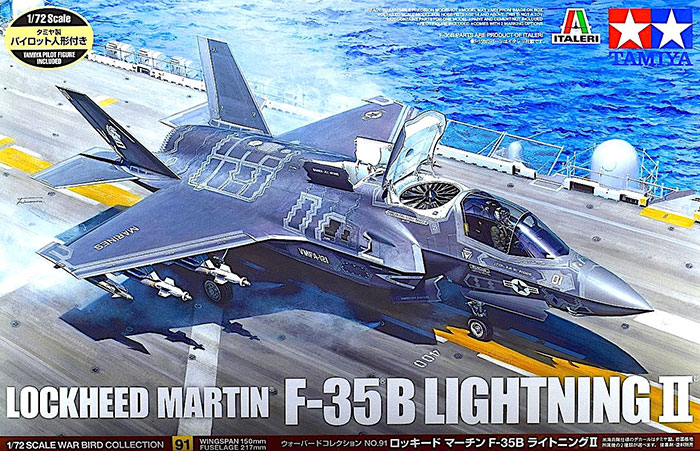
Tamiya (ex-Italeri), 1/72 scale
S
u m m a r y : |
Description and Item No.: |
Tamiya Kit No. 60791 - Lockheed Martin F-35B Lightning II |
Contents and Media: |
133 parts in grey styrene (not all are used), 3 in clear brown, and one decal sheet with markings for 2 airframes. |
Price: |
GBP£35.99 EU Price (£30.00 Export Price) Plus Shipping at Hannants |
Scale: |
1/72 |
Review Type: |
First Look |
Advantages: |
Moulded details within the internal bomb bay area beautifully done as are the surface details, ordinance, and decals. |
Disadvantages: |
None noted. |
Recommendation: |
The kit layout is simple and straightforward with no apparent issues lying in wait. There’s no flash to contend with and detail abounds in areas like the internal bomb bay, ordinance, and wheel wells. The option to build the airframe configured for flight or take-off/landing will make a lot of builders happy. Ditto that for the decal sheet, which is crisply printed with an abundance of airframe details that will look very convincing when complete. Highly Recommended! |
Reviewed by John Miller

The Lockheed Martin F-35 Lightning II is a family of single-seat, single-engine, all-weather stealth multirole combat aircraft that is intended to perform both air superiority and strike missions. It is also able to provide electronic warfare and intelligence, surveillance, and reconnaissance capabilities. Lockheed Martin is the prime F-35 contractor, with principal partners Northrop Grumman and BAE Systems. The aircraft has three main variants: the conventional take-off and landing F-35A (CTOL), the short take-off and vertical-landing F-35B (STOVL), and the carrier-based F-35C (CV/CATOBAR).
Design and Development:
The F-35 is a family of single-engine, supersonic, stealth multirole fighters. The second fifth generation fighter to enter US service and the first operational supersonic STOVL stealth fighter, the F-35 emphasizes low observables, advanced avionics, and sensor fusion that enable a high level of situational awareness and long range lethality. The USAF considers the aircraft its primary strike fighter for conducting suppression of enemy air defence (SEAD) missions, owing to the advanced sensors and mission systems. The F-35 has a wing-tail configuration with two vertical stabilizers canted for stealth. Flight control surfaces include leading-edge flaps, flaperons, rudders, and all-moving horizontal tails (stabilators); leading edge root extensions also run forwards to the inlets. The relatively short 35-foot wingspan of the F-35A and F-35B is set by the requirement to fit inside USN amphibious assault ship parking areas and elevators; the F-35C's larger wing is more fuel efficient.
Edited from Wikipedia
The kit's grey plastic parts (by Italeri) are conveyed on two large and one small sprue, all individually bagged. Parts are clear of flash and the fidelity of detail is quite nice. The surface details are finely rendered and scale appropriate. The plastic has a satin finish that’s perfect for receiving a coat of primer. Parts layout and engineering are conventional for modern-day jets suggesting this will be a straightforward build.
The fuselage-wing is comprised of upper and lower halves so there are very few airframe parts to deal with. Assembly begins with the cockpit, wherein the nicely moulded, 3-piece ejection seats look very nice. Instrument panel details are provided by a crisply printed decal.

With the completed cockpit tub affixed to the upper fuselage half, the builder is directed to the multi-part engine that includes the drive shaft projecting to the forward lifting fan. The detail here is very nice but unfortunately much of it will be lost when the fuselage halves are joined.
The intake trunks are comprised of multiple parts but it appears the seams have been efficiently hidden by some clever engineering. Once the trunks are installed, the main gear and wells are assembled and glued into the bottom halve of the fuselage, and the fuselage halves are joined together.
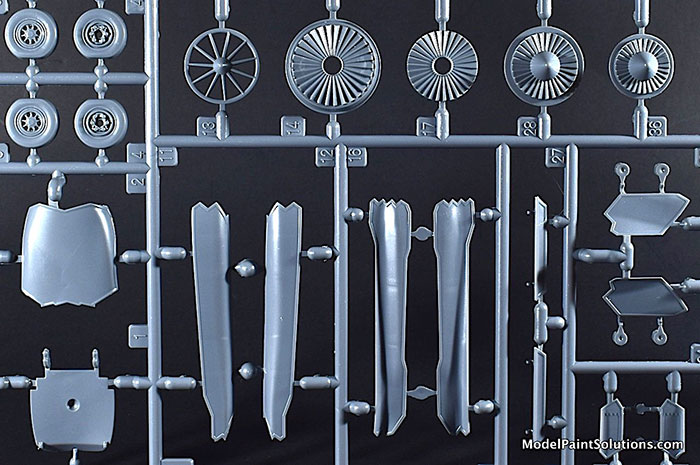
The builder is directed to assemble the nicely detailed nozzle assembly next, which can be built pointed to the rear as if in flight or vectored downward as for take-off/landing. Two different sets of nozzle cover doors (for flight and landing) are provided.
The main wheels/tires are comprised of halves while the nose wheel is a single piece. All have a flattened area simulating weight; nice. The gear doors and hinges/actuators are all nicely moulded and free of flash. Instructions are provided for placing the many decals that adorn the outer faces of the gear doors, which will look very convincing.
The internal bomb bay can be posed open or closed. It seems a shame to pose it closed given the all the amazing detail provided here. This is a very nice piece of moulding that will look awesome under paint and a wash.
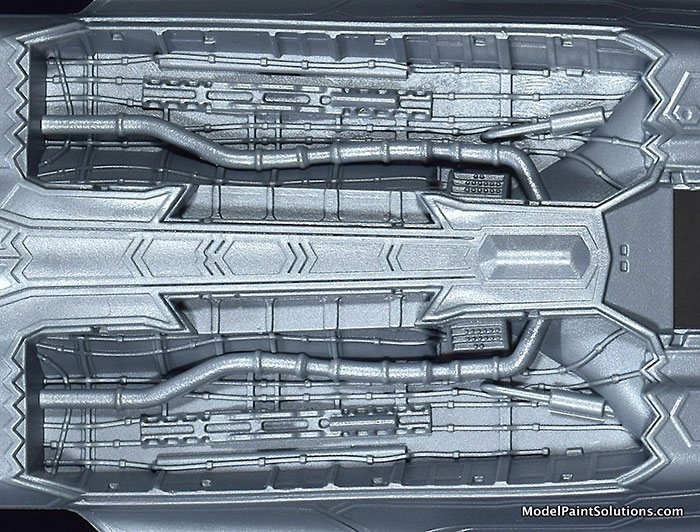
Like the gear doors, the bomb bay doors are nicely moulded with well detailed hinges and actuators should you choose the open option. Two nicely moulded AIM-120 AMRAAM missiles are provided for the bomb bay. Painting and decaling (3 decals per missile) instructions are provided.
After completing the internal bomb bay the builder is directed to assemble the wing hard points (3 per side) and the associated ordinance, which includes four GBU-12 Paveway II guided bombs and two AIM-9 Sidewinder missiles. As with the AIM-120 missiles, detailed painting and decaling instructions are provided.
The nicely moulded vertical stabilizers, flaperons, and horizontal stabilators are added next followed by the cover for the lifting fan, which can be posed open or closed. This largely completes the airframe.
The clear parts are moulded in a bronze-brown coloured plastic that is crystal clear with scale appropriate framing. The canopy, which hinges forward, can be posed open or closed.
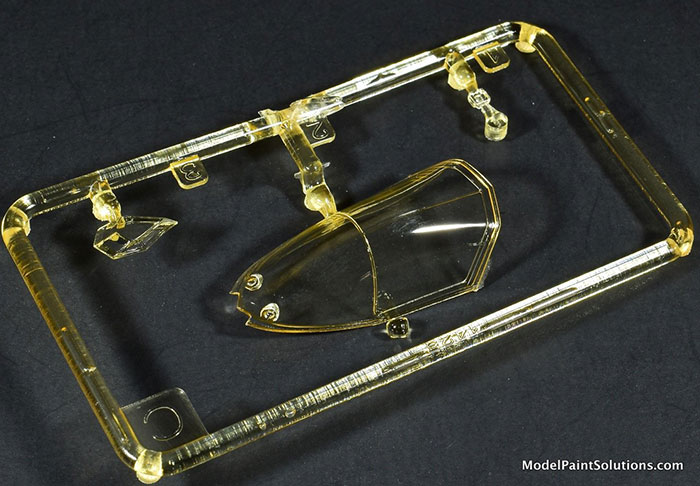
A nice touch is the inclusion of a well-detailed, multi-part missile cart for displaying two of the GBU-12 bombs.
Markings:
The decals, by Tamiya, are well printed with good registration and colour density.
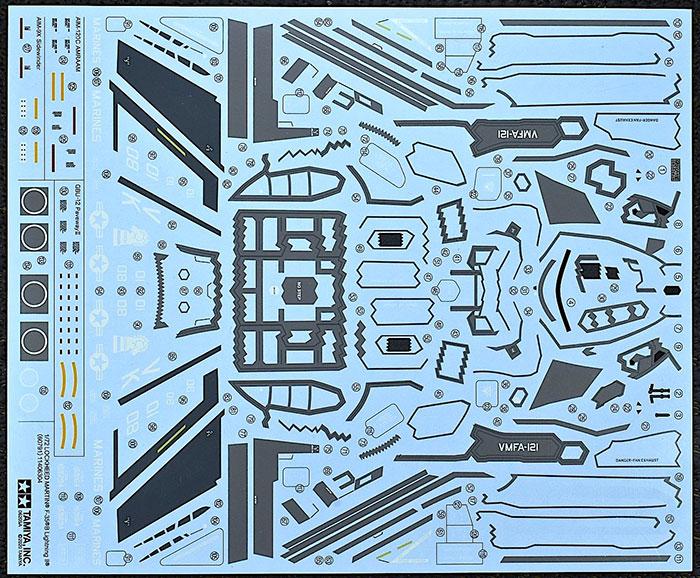
Markings and extensive airframe stencil data are provided for two airframes as follows:
F-35B Lightning II, U.S. Marines Corp, VMFA-121, “01”, 2017, MCAS Iwakuni
F-35B Lightning II, U.S. Marines Corp, VMFA-121, “08”, 2017, MCAS Iwakuni
The kit layout is simple and straightforward with no apparent issues lying in wait. There’s no flash to contend with and detail abounds in areas like the internal bomb bay, ordinance, and wheel wells. The option to build the airframe configured for flight or take-off/landing will make a lot of builders happy. Ditto that for the decal sheet, which is crisply printed with an abundance of airframe details that will look very convincing when complete. Highly recommended!
—John
For more on this review visit Modelpaintsolutions.com.
Review kit provided by my retirement fund, again.
Review Text and Images Copyright © 2020 by John Miller
Page Created 12 November, 2020
Last updated
12 November, 2020
Back to HyperScale Main Page
Back to Reviews Page
|
Home
| What's New |
Features |
Gallery |
Reviews |
Reference |
Forum |
Search